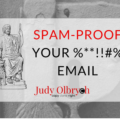Checking the mail isn’t what it used to be.
When I was growing up, the mail came every afternoon at about 2 o’clock. My brother and I always raced to check it on the way home from school. When my dad came home, he’d bring it into the living room, pull a metal wastebasket in front of his chair and look at each piece right away.
Dad was the best spam filter ever – back when the word meant salty pink processed meat in a twisty-keyed can.
He usually laid a couple of envelopes aside. Then he ripped the rest of the unopened letters, flyers, postcards, and brochures in half and dropped them into tinny oblivion.
Each letter had to look personal and important or it never saw daylight. Dad didn’t have time to waste on junk – and that was back when we generally received fewer than 6 letters per day.
Today we’re bombarded 24-7 with e-messages of every kind.
We are surrounded by electronic noise. Emails inform us about everything from vitamins to political causes. They remind us to sign up for team snacks, concert ushering, and committees. They offer us opportunities to rescue foreign royalty and find obscenely hot dates. When we add email from work, professional organizations, family, and social media, it can seem overwhelming.
Then, when we try to fix the problem, many of us squander hours checking our inboxes to make sure we haven’t missed anything important!
Anyone who’s digitally connected is in danger of communication and information overload.
So … what if you’re the sender?
So … what if you are the sender? You’re on the other end of the email and want to make sure that yours is getting opened like it’s Christmas morning. How are you going to keep your messages out of the digital trash can when your prospects are sorting through dozens of emails per day?
Think about the reasons you open email.
The winners will have to meet personal criteria before they get clicked. Some will also have to get past VAs to reach their targets.
And, in rare cases, you could be emailing someone like Dan Kennedy who won’t even touch email. His assistant might summarize it, but don’t hold your breath. Send him a fax or handwritten note, or he may never see your message.
Whatever the situation, if you’re a marketer, you need to get those emails past the gate-keepers, opened, read, and clicked. Your success depends upon it.
Here are some quick tips for writing emails that get opened
1 – Dodge the Electronic Watchdogs
Before your emails get opened, they’re going to have to get past the spam filters. Check your subject lines and body content for trigger words and other elements that put automatic filters on alert. Take out the offending parts, run them through a test or two, and they should be fine (as long as you’re not blocked for another reason). I have another complete post on that. You can read it here. You can even download my free list of trigger words to avoid. Check it out.
2 – Get Past the Human Filters (With a Great Email Subject Line)
Write a compelling subject line. There are many ways to do this, but the approach you use will depend on who you are, what your relationship to the recipient is, and what they want.
Here are some approaches that can work well:
- Shock and awe
- Curiosity factor
- Top 10
- A specific number of helpful tips
- Thought provoker
- Asking a question
- Giving away something free that they actually want
- Fear and salvation
- Positive results
- Urgency
- Let them get to know you along the way
- Help you get to know them
- Or any combination of the above
Here are some that generally don’t get great results (but people use them anyway)::
- Talk about negative results
- Make them think about depressing topics without immediate tangible hope
- Take away their hope
- Be boring
- Be all about you
- Sound like a robot or a tacky sales call
- Offer them something they don’t want or care about
3 – Provide Great Content
First, send content that your prospect actually wants. He should feel excited about the wonderful things he’s going to read, learn, or get every time he opens your email. If your emails don’t consistently
- solve problems
- bring a smile
- eliminate pain points
- provide entertainment
- help readers work faster and better so they have more time with family or to work on the golf swing
- make others feel like they have a friend who cares
- or answer relevant burning questions,
… your readers may lose interest. Yep, they’ll trash your messages even if they’re well-written, compelling and informative.
Instead, find a pain point to fix or solve a problem. Can you give valuable information that makes the reader’s life more comfortable? Can you share a resource to help work go faster or bring in more sales with less work? You’re on your way to opened.
As a rule, be generous. Share resources, send links to helpful videos and webinars, and link to helpful blog posts. But don’t be too generous. You need to maintain a balance. When you write email, give value, but also make your readers hungry for what you can give them and ready to buy it.
If you’re just starting out, you might follow a simple rule like this:
Email 1 – give
Email 2 – give
Email 3 – sell
Repeat
4 – No Clever Tricks
If your email subject line doesn’t lead naturally to the content in your email like a stream to a river, you may as well be writing to the tumbleweed. If your email links don’t match the content they lead to, your email may come across as being deceptive.
Now, sometimes people are misleading on purpose … all in a spirit of fun. But it’s better not to be clever when there’s any chance that your efforts will come across as a trick. If you do that, the joke will be on you.
Promise what you can give, and deliver on that promise. This will help you build trust. And just think about it … If you don’t trust someone, do you open their mail? Dad didn’t. I don’t. And I don’t think you do either.
5 – Find the Right Frequency
I’m not talking about radios or intoning Tibetan gongs, although if those help you write, go for it. This is about how often you broadcast your emails.
First of all, there seems to be a consensus among marketers that the worst thing you could ever do in email marketing is to not send any emails at all. On the other hand, I unsubscribe to almost every daily poster unless their headlines and content contain fantastic copywriting I can use to build my own swipe file.
Bombarding people with daily emails may work for you if the content is exactly what your list wants. It can also work if you have developed strong relationships. You need a tribe that wants to keep a conversation going and is willing to respond.
Ian Brodie does both for email marketers. He gives useful content in his messages. He’s so personable at the same time, it feels as though I’m hearing from a friend or trusted colleague. I think that may actually be his brand. He draws me in by being like the favorite guy friend from down the street … the smart, dependable one that shows you great tricks like how to set off firecrackers in the drainpipes without getting your fingers blown off. Just speaking theoretically, of course.
Darren Harding also accomplishes both for a wide audience. Most of his Darren Daily posts link to short, positive coaching-style videos. He chooses topics that help viewers begin each business day with positive and helpful reminders. Other emails link to short articles on everything from prioritizing tasks to evaluating your work and social circles.
Email frequency can also be seasonal. You may only have the resources to send one or two quality emails per week. However, you’ll want to email more frequently when it’s time to promote a new product or a launch a course. After the launch, you can easily taper back to what was working for you.
I guess the rule of thumb here is that it’s an individual thing. If you have gazillions of pages of really fabulous, valuable content that brings you fans and clients, keep sending it. If you’re coming up with something not-so-useful just to stay in touch every day, it might be best to pull back a bit. In the end, your numbers will tell you what to do – it’s just something to be aware of
6 – End with a Cliffhanger.
Give them the first half of an article that will help them immensely … draw them into a fascinating story… then promise them the conclusion the next day.
Or offer a free mini-course. Each day, send a new lesson. All the lessons work together to teach a concept and lead them to a product or service (see Josh Earl for great advice on this).
Or tell them you’re going to solve their problems …
And follow up with your conclusion, offer, or solution the next email

